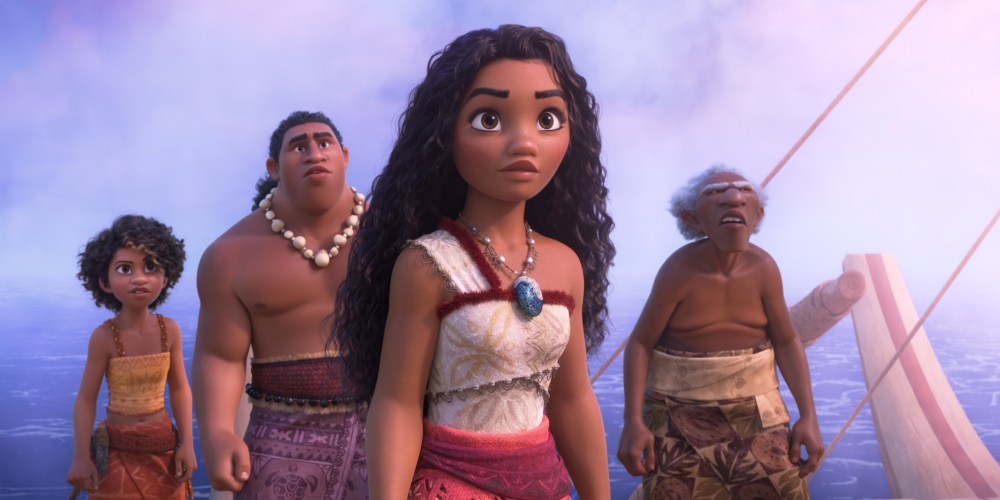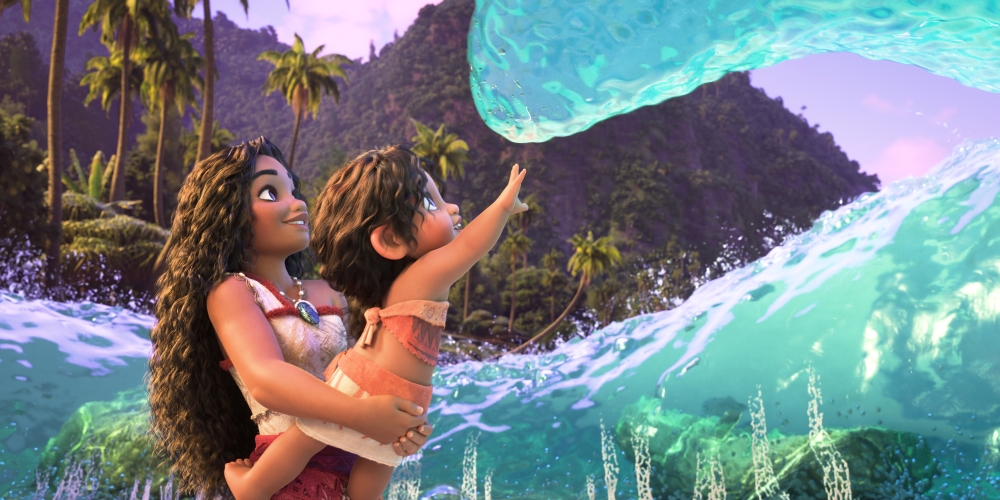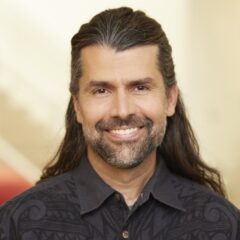|
Getting your Trinity Audio player ready...
|
When audiences met Moana almost a decade ago, the determined heroine couldn’t wait to find out how far out to sea she might go on a quest for adventure. As we return to find her in Moana 2, the passionate young leader is several years older when she’s called once again by destiny to serve her people. This time it gives her pause, though. She knows to head out on another quest means leaving her village and family behind. As she considers her life path, she struggles with the choice.
Directors David Derrick Jr. (previously a story artist on Moana, Encanto and Strange World), Jason Hand (formerly head of story on Encanto and a story artist on Zootopia) and Dana Ledoux Miller (whose past credits include writing for Narcos and Designated Survivor) wanted to show audiences a new Moana who has grown into her role as a leader of her people but still hears the call to adventure.
For Ledoux Miller, who is Samoan American, honoring Moana’s heritage was especially important in the story.
Evolution of a Friendship
“As a first-time director, stepping into a huge film and with a huge crew, learning new things about animation, I feel like I’ve learned a lot about being a leader and the kind of leader that I want to be moving forward,” says Ledoux Miller. “I think we’re constantly pushing ourselves to be better and to do right by Moana and tell her story. I’d say for me, what’s really resonated, and especially as the story goes on after what you’ve seen, is that connection between Maui and Moana. It’s important to me to build on that friendship that started in that first film. They both were changed by meeting each other. So, we are exploring this idea of how they changed each other and how they might continue to push on each other.”
Ledoux Miller believes what’s fascinating about the two characters in the first film is they don’t let each other get away with anything. She adds, “That’s still very much true in this film. Caring about someone and developing a deep friendship with someone changes you. It makes you vulnerable in ways that you know you weren’t before you had that relationship. It was really exciting to push on that and to see what our animators have done [with] those performances, the depth and the nuance of the acting.”
![Dana Ledoux Miller [ph: Evan Mulling]](https://www.animationmagazine.net/wordpress/wp-content/uploads/DanaLedouxMiller-Headshot-3_Evan-Mulling-240x240.jpg)
‘It’s important to me to build on the friendship between Maui and Moana. So, we are exploring this idea of how they changed each other and how they might continue to push on each other.’
— Director Dana Ledoux Miller
Hand felt the return of Auli‘i Cravalho as Moana was especially important for what the actor brings to the role. He also believed she brought a sense of continuity for the audience.
“She was cast as Moana at 14 years old, so she’s come a long way on this journey, and we couldn’t be more excited about what she’s brought back into the recording of Moana 2 and really just who she is as a person,” says Hand. “We’ve been really fortunate on this film to have her come into the studio several times to just share what this movie means to her. She’s grown up with Moana, but, even more than that, just what it means to her as a Hawaiian and how this story has really impacted the world in a much larger way.”

Moana 2 boasts the returning vocal talents of Cravalho in her signature role as Moana and Dwayne Johnson in his unforgettable role as Maui. The voice cast also includes Rachel House (Gramma Tala), Temuera Morrison (Chief Tui), Nicole Scherzinger (Sina), Hualālai Chung (Moni), David Fane (Kele), Rose Matafeo (Loto), Awhimai Fraser (Matangi), Gerald Ramsey (Tautai Vasa) and Khaleesi Lambert-Tsuda, who plays Moana’s adoring, feisty little sister, Simea.
In addition, Moana 2 features music by Grammy winners Abigail Barlow and Emily Bear, Grammy nominee Opetaia Foa‘i and three-time Grammy winner Mark Mancina. Jared Bush (Encanto, Moana, Zootopia) and Ledoux Miller wrote the film, which is executive produced by Jennifer Lee, Bush and Johnson.
Saying Aloha to New Faces
Because this is a new chapter in Moana’s life, we meet some new characters on the way. None of them is more vibrant or energetic than Simea, who is Moana’s baby sister. Animator Kevin Webb happened to have a daughter who was around the same age as Simea when he started working on the film. His daughter and home videos of her running, playing and having everyday adventures became perfect references for Simea’s movements, facial expressions and unique look.
“I would watch my own daughter running or walking around at the age of three or so, and you see she’s excited but bumping into things. But that’s the way kids this age move, and it was great to have that as a reference for Simea, who really wants to be like her big sister and do all the things her big sister does, but she doesn’t quite have the coordination to do it yet,” says Webb. “So she’s trying and that contrasts with Moana, who has grown up a bit. We haven’t changed her that much, but there are subtle things. Her hair is different, like Moana has a little comb-over now that kind of comes in front of her face. She’s also someone who is very stronger in mind and physically fit, so you see she is a little more muscular.”

‘These new animation tools have allowed us to put something even bigger up on screen. We wanted to maintain the look of the film but just continue to push it further. And I think that’s what our team’s done.’
— Director Jason Hand
Possibly the most personal influence on the look of Simea came from both Webb and his daughter.
“When I was growing up, I had buck teeth for a long time and then, sure enough, my daughter had the same thing, and it kind of influences how you speak,” says Webb. “It was something we gave Simea that just gave her this sort of adorable look.”
In the eight years since the first film was released, new tools have evolved and others have been refined. Both developments gave the animators more possibilities in terms of movement and emotion.
“These tools have allowed us to put something even bigger up on screen,” says Hand. “We have more characters. The world where Moana lives and the places where she goes are more lush and beautiful than they’ve ever been. The water looks incredible. There’s foam up on top of the water, and our production designer was always so excited about it. It’s so great because we get to use all this incredible technology to make the film even more layered for the audience while we still kept the look of the first film. We were able to introduce all kinds of new, fun and interesting characters. We wanted to maintain the look of the film but just continue to push it further. And I think that’s what our team’s done.”
Crafting this new depth to Moana 2‘s deeps wasn’t completely smooth sailing, despite the new tech, visual effects supervisor Carlos Cabral recalls. “Working with water was one of the very first early challenges. We haven’t done water at that scale since the original film. We’ve had water in some of our other films, but not the with the performance required,” he explains. “We knew this water in this film was going to be was a challenge, and so we did coordinate between both locations — Burbank and Vancouver — of our one studio. We worked together to come up with a strategy. We wanted to take our water and our water system to the next level . And so all of these three things — the tools, the process, the workflows — were all updated and we were working in a new paradigm with it.”
With these refined tools, not only was the movement of the water more specific but the delicate facial movements and physical stances of the characters were also more precise. This gave animators more choices when deciding how characters would act.
“I think a good example of that is we had some controls over some of her muscles, if we wanted to dial in on her bicep, for example, that was something that was different between the old film and this film,” says Webb. “This was a huge part of redeveloping the way Moana would move as someone who is now older, stronger and not a small kid anymore. There are also some new features in her face and new muscles that can be triggered in her face. For example, the mentalis muscle, which is the kind of muscle in your chin that is triggered when you begin to cry, is something we have more control over now. So, we show Moana and her little sister moving those muscles because [we] need to break some hearts. These little updates have allowed us to open up new acting possibilities.”

Poetry in Motion
The creators on Moana 2 pushed further into new movements by working with a choreographer to develop a range of actions, dances and expressions. Sometimes when they needed a reference for a kind of movement that wasn’t so clear to them, this gave them a starting point for their designs.
“[Choreographer] Tiana Liufau was amazing to work with,” says Webb. “A lot of times we would look at a musical sequence and we would think maybe there’s some movement that can be more specific, and she would come right back to us with something that just fit. Other times we would be looking for a hand gesture or something that would fit with a moment or song, and she would come back to us with the perfect thing.”

Derrick was deeply touched by these specific movements while directing the movie. With his own ties to Moana’s cultural background, there was one moment that stays with him and bolsters the meaning of the film:
“Speaking culturally, and for the story, one of my favorite moments in the film is where Moana is receiving the title from her father and from her village” he says. “There’s so much care and consideration went into every single frame of that. I love how it shows the specificity of culture, but it also shows the love of the community.”
Less tender but equally effective motion rocks the screen in the film’s climactic, supernatural tempest. “[The biggest production challenge] was probably the storm sequence and manifestation of that magical storm controlled by our antagonist in the film,” notes VFX supervisor Kyle Odermatt. “That involved a huge collaboration between multiple departments working on it to try and capture the scope and the vision and what directors had in mind and provide the visualization and options so we could all formulate the idea together or come to the end result together. That sequence was a lot of interaction with the ocean, a lot of performance by the ocean, but also clouds, lightning, and all of our main characters involved. It was all the departments, modeling environments, effects, characters, everyone working at together at the same time.”
“There was lots and lots of research on storms and tornadoes, and we referenced a lot of tornado footage,” Cabral adds. “We also looked at a lot of wave structure and we researched different types of seas. So we had a scale of intensity for the ocean that we could give to the directors. This way the directors would reference it in terms of what they’re envisioning for the intensity of the water.”
Luckily, the sequel’s themes of coming together were reflected throughout the challenging production, as the Disney animation and VFX teams in both Burbank and Vancouver found a collaborative rhythm to bring Moana 2 to life.
“We didn’t distinguish [between the facilities], so there was leadership and artists in both locations,” says Odermatt. “We had commingled crews and shots were cast by the particular nature of a given challenge, not by where an artist or supervisor was located. In the modern world with remote work and hybrid work workflows, it really has opened up many possibilities. It’s fabulous that we all got to work on this project together.”
Disney’s Moana 2 opens in theaters nationwide on November 27. Check out the latest sneak peek, “Big, Bad Matangi,” below. You can watch the official trailer here.
















 Win 'The Art of DreamWorks Dog Man'!
Win 'The Art of DreamWorks Dog Man'! 

